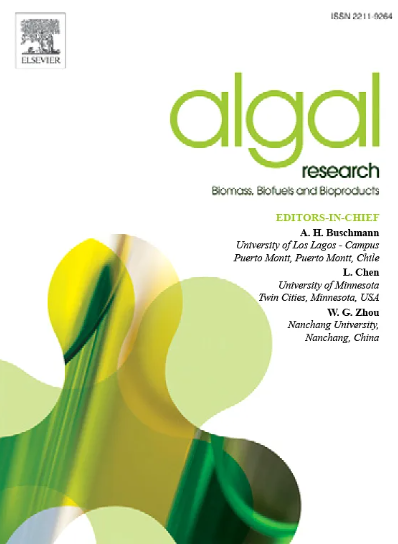Ultra-large adsorption capacity for tetracycline by defatted Schizochytrium limacinum residue biochar
IF 4.6
2区 生物学
Q1 BIOTECHNOLOGY & APPLIED MICROBIOLOGY
Algal Research-Biomass Biofuels and Bioproducts
Pub Date : 2025-03-20
DOI:10.1016/j.algal.2025.104011
引用次数: 0
Abstract
Tetracycline (TC) is the one of the largest used antibiotics and its resulting water environment pollution has received widespread attention. In this paper, biochar was prepared by using the defatted Schizochytrium limacinum (microalgae) residue as raw material and KHCO3 as activator, and its adsorption properties for TC were investigated. The results showed that KHCO3-activation biochar possessed the developed hierarchical porous structure. The specific surface area was up to 2295.26 m2·g−1, which was 409.6-fold higher than the pristine biochar. When the mass ratio of the pristine biochar to KHCO3 was 1:1, the as-prepared biochar displayed the best adsorption performance for TC. The pseudo-second-order reaction kinetics can better describe the kinetic experiment results. The maximum adsorption capacity was 1357.5 mg·g−1, which was more favorable than other biochar derived from agricultural waste reported previously. The adsorption capacity was stable under different solution conditions, suggesting that the microalgae residue-based biochar has a promising application foreground in wastewater treatment.

求助全文
约1分钟内获得全文
求助全文
来源期刊

Algal Research-Biomass Biofuels and Bioproducts
BIOTECHNOLOGY & APPLIED MICROBIOLOGY-
CiteScore
9.40
自引率
7.80%
发文量
332
期刊介绍:
Algal Research is an international phycology journal covering all areas of emerging technologies in algae biology, biomass production, cultivation, harvesting, extraction, bioproducts, biorefinery, engineering, and econometrics. Algae is defined to include cyanobacteria, microalgae, and protists and symbionts of interest in biotechnology. The journal publishes original research and reviews for the following scope: algal biology, including but not exclusive to: phylogeny, biodiversity, molecular traits, metabolic regulation, and genetic engineering, algal cultivation, e.g. phototrophic systems, heterotrophic systems, and mixotrophic systems, algal harvesting and extraction systems, biotechnology to convert algal biomass and components into biofuels and bioproducts, e.g., nutraceuticals, pharmaceuticals, animal feed, plastics, etc. algal products and their economic assessment
 求助内容:
求助内容: 应助结果提醒方式:
应助结果提醒方式:


